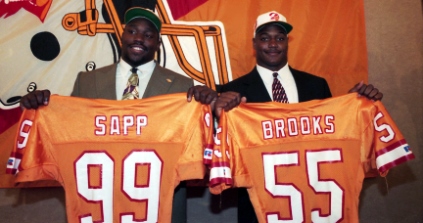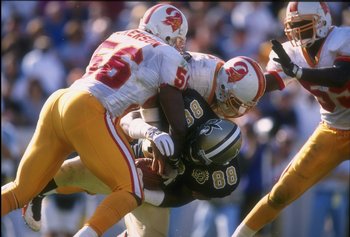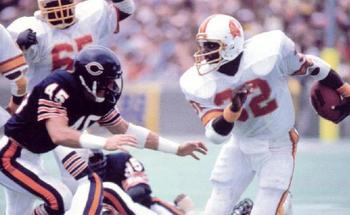@HighwaytoHall
With Warren Sapp, his employers have to take the good with
the bad. As a defensive tackle, he was as disruptive a force as the NFL has
ever seen. He also talked a lot, creating controversy in the process. In recent
months, Sapp’s name has appeared multiple times involving Highway to Hall topics,
so now is a good time to discuss them.
Let’s start with the good:
On November 11, defensive tackle Warren Sapp will become the
fifth member of the Tampa Bay Buccaneers’ Ring of Honor.
The Ring of Honor, introduced in 2009, includes Hall of Fame
defensive end Lee Roy Selmon (2009), head coach John McKay (2010), tight end Jimmie
Giles (2011), and left tackle Paul Gruber (2012). A new member is added each
year.
The Bucs first paid tribute to former players and coaches
with the Krewe of Honor, which was established in 1991 and unveiled that year
at halftime of the December 8th game against the Minnesota Vikings.
The charter members of the group were Selmon, McKay, and running back Ricky
Bell. Quarterback Doug Williams was enshrined in 1992 while owner Hugh
Culverhouse was added in 1993. Members of the Krewe were honored with giant
murals in Tampa Stadium, but when the stadium was demolished in 1998, so was
the Krewe.
When the Glazers purchased the Buccaneers in 1995, they
tried to erase the memories created by the franchise that had lost 10 or more
games in 12 consecutive seasons. They built a new stadium and changed the logo
and team colors. Players including Sapp and Derrick Brooks advocated for a Ring
of Honor. In Brooks’ words, “Honoring history is something we need to do.”[1] In
2009, that goal finally came to fruition.
At first it seemed the Bucs may honor players and coaches in
chronological order, as the selection of Giles as the third member of the Ring
struck some as unusual. The selection of Sapp, however, refutes that theory.
Perhaps that was Tampa’s goal, but once Sapp was tabbed to join the NFL Hall of
Fame, it would seem odd to not have him as a member of the franchise’s Ring of
Honor. On that note, the next member of the Ring of Honor will undoubtedly be
Derrick Brooks, who will join Sapp in the NFL Hall of Fame next year in his
first year of eligibility. For now, let’s take a look at future members of the
Bucs’ Ring of Honor.
One of the
finest cornerbacks to wear a Buccaneer uniform, Abraham left Tampa as its
all-time interception leader with 31. He intercepted 2 Brett Favre passes in
the 1997 NFC Divisional Playoff Game loss to the Green Bay Packers. He was
selected to the NFC Pro Bowl team in 2000.
Alstott
was a fan favorite due to his unwillingness to be tackled. Known as the
A-Train, train whistles were a staple at Buccaneers games during his tenure.
Alstott was named to 6 consecutive Pro Bowls and he was selected 1st
Team All-Pro three times. He is Tampa’s leader in rushing touchdowns with 58,
while ranking as its second leading rusher with 5,088 yards on 1,359 carries.
He is also fourth in receptions with 305. He scored 4 touchdowns in the 2002
playoffs in leading the Bucs to a Super Bowl victory.
Barber was
selected to 5 Pro Bowls and named a 1st Team All-Pro three times. He
was named to the NFL All-Decade Team of the 2000s. He is Tampa’s all-time
leader in interceptions (47) and games started (232), while ranking 2nd
in tackles (1428). His game-sealing 92 yard interception return for a touchdown
in the 2002 NFC Championship Game against the Eagles stands as the most
memorable play in franchise history.
Bell
rushed for 1,263 yards in 1979. He carried the ball 38 times for 142 yards and
2 touchdowns in the 24-17 win over the Philadelphia Eagles in the 1979 NFC
Divisional Playoff Game. He died in 1984 of polymyositis.
Derrick Brooks
As
depicted in a United Way commercial, Brooks asks a bus full of children, “Who’s
your favorite player?” The response: “Mr. Derrick Brooks.”
A fan
favorite throughout his stay in Tampa, Brooks was the 2002 NFL Defensive
Player of the Year, a Member of the 2000s All-Decade Team, an 11-time Pro
Bowler, and a 5-time 1st Team All-Pro. He was named 2nd
Team All-Pro 4 times. He is Tampa’s All-Time leader in tackles with 2,198.
Brown
played nine seasons as a Buccaneer, setting a then team record with 9
interceptions in 1981. He still ranks third on Tampa’s all-time interception
list with 29. Brown intercepted 2 key Eric Hipple passes in the final game of
the 1981 season, which helped allow the Bucs to claim a 20-17 victory over the
Detroit Lions and win the NFC Central Division title. The following season, his
fumble recovery against the Buffalo Bills on December 19, 1982 preserved
Tampa’s 24-23 victory, and started a streak of 3 consecutive wins to close out
the season and capture another playoff berth.
Carrier is
the Bucs All-time leader in receiving yards with 5,018. He stands 4th
in receiving TDs with 27. He was named a Pro Bowler in 1989, a season which saw
him eclipse the 100-yard receiving mark 9 times. He is 1 of 10 rookies in NFL
history with 200 or more yards receiving in a game as he caught 8 passes for
212 yards in a 44-34 loss to the New Orleans Saints on December 6, 1987.
Selected
in the Expansion Draft in 1976, Cotney served as Tampa’s starting safety for
most of the franchise’s first 9 seasons (though missing the entire 1981 season
to injury). A fan favorite, Cotney intercepted 17 passes and recovered 6
fumbles in 113 career games with Tampa. He was selected to Sports Illustrated’s
1983 All-Pro Team.[2]
Hired by
Tampa in 1996 to replace Sam Wyche as head coach, Dungy helped turn the Bucs
franchise around. After a 6-10 season in 1996, Dungy led the Bucs to 5
consecutive non-losing seasons (8-8 in 1998) and 4 playoff appearances. In his
6 seasons as head coach, Tampa won 54 games and had a .563 winning percentage.
He was named to the NFL All-Decade Team of the 2000s as the 2nd Team
head coach.
Dunn
teamed with Alstott to form the rushing tandem known as “WD-40.” Dunn twice
surpassed 1,000 yards rushing in a season and was named to 2 Pro Bowls during
his Buccaneer career. He stands as Tampa’s third leading rusher with 4,986
yards on 1,256 carries. He also ranks third in receptions with 306. He was
named the 1997 NFL AP Offensive Rookie of the Year. Dunn scored 3 touchdowns in
Tampa’s dramatic 38-35 victory over the St. Louis Rams on Monday Night Football
on December 18, 2000.
Jon Gruden
Despite
Dungy’s success, his conservative offense led to his firing following the 2001
season. Tampa then traded 4 draft picks to Oakland for Gruden. Gruden
immediately led Tampa to its first Super Bowl title. In 6 more seasons with the
club, Gruden led Tampa to 2 playoff appearances. After losing 4 games in a row
to end the 2008 season, resulting in a 9-7 record, Gruden was fired. He is
Tampa’s winningest coach with 57 wins.
The best
deep threat in team history, House ranks first in yards per reception (minimum
200 receptions) at 17.2 (Joey Galloway ranks second at 15.8). House is 2nd
all-time in receiving yards with 4,928 (trailing Carrier) and receiving
touchdowns with 31 (trailing Giles). He was Tampa’s first player to reach 1,000
yards receiving in a single season, surpassing the total twice in his Buccaneer
career. His 71 yard touchdown reception with 9:39 to play enabled the Bucs to
defeat the Atlanta Falcons 24-23 on December 6, 1981. His 84-yard 2nd
quarter touchdown reception 2 weeks later against the Detroit Lions gave the
Bucs a lead they never relinquished in a 20-17 win that allowed the Bucs to
clinch the NFC Central Division in the final game of the season.
Though
only a Buccaneer for 4 seasons, Johnson led Tampa to a 26-23 record during his
tenure and a Super Bowl title. He passed for more than 3,000 yards in each of
his 3 full seasons in a Buccaneer uniform. Johnson connected with Joe
Jurevicius on a 71-yard pass play to set up the go-ahead score in the 2002 NFC
Championship Game against the Eagles.
Monte Kiffin
Kiffin was
Tampa Bay’s legendary defensive coordinator from 1996 to 2008 and is the
architect of the Tampa-2 defense. Only twice in his tenure did a Buccaneer
defense finish outside of the top 10 in either points allowed or yards allowed.
During his tenure, the Bucs set the NFL records for most consecutive games with
a sack (69) and the most consecutive games with a sack and a forced turnover
(50).
Once named
a Sporting News 1st Team All-Pro and twice selected to Pro Football
Weekly’s All-Conference Team, Logan started a then team record 103 consecutive
games from 1980-1985. Playing the nose tackle position in Tampa’s 3-4 defense,
he ranks 4th on the career sack list with 38.5. His 21-yard 4th
quarter fumble return for a touchdown against the Detroit Lions on December 20,
1981 gave the Bucs a 20-10 lead which they held on to win 20-17 and clinch the
NFC Central Division title. Logan later became a color analyst for radio
broadcasts of Buccaneer games.
A key
member of Tampa’s Super Bowl winning team, Lynch was a 9-time Pro Bowler with
the Bucs and a 2-time 1st Team All-Pro. His interception in the 3rd
quarter helped set up the Bucs first touchdown in Tampa’s 14-13 victory over
the Washington Redskins in the NFC Divisional Playoff on January 16, 2000.
Tampa
Bay’s starting center for 9 straight seasons, Mayberry started 144 consecutive
games. He was named to the Pro Bowl in his final 3 seasons in a Buccaneer
uniform.
As
described by St. Petersburg Times writer Gary Shelton, Nickerson “was that rare
free agent who was worth every penny. He came here talking of a better day, and
by golly, he helped make it happen. There were times in those early days when
there would be an impact, and the running back would go down, sudden and limp,
and you wouldn’t have to check to see who made the tackle. It was Hardy. He
played with a fury, and he infused those around him with it.”[3]
Nickerson was named to 5 Pro Bowls as a Buccaneer. He was a 2-time 1st
Team All-Pro and named to the NFL All-Decade 2nd Team of the 1990s.
A
tragically underrated player, Quarles served as Tampa’s starting middle
linebacker for 5 seasons, after moving over from the left side following Jamie
Duncan’s departure. Described by Sports Illustrated as “an amazingly gifted MLB
with terrific speed and range,” [4]
Quarles was named to the 2002 Pro Bowl. He returned a Brett Favre pass 98 yards
for a touchdown in a 14-10 victory over the Green Bay Packers on October 7,
2001.
Rice
terrorized quarterbacks from his defensive end position from 2001-2006. Despite
spending only 6 seasons in Tampa, Rice is third on the Bucs’ all-time sack list
with 69.5, trailing only Sapp and Selmon. He recorded 2 sacks in Super Bowl
XXXVII.
Washington
started 96 games at cornerback between 1976 and 1983. He stands fourth on
Tampa’s all-time interception list with 28. His third quarter interception
return for a touchdown against the New Orleans Saints helped lead the Bucs to
its first franchise victory on December 11, 1977.
Tampa’s
offense through much of the 1980s, Wilder is the all-time leading rusher
(5,957) and receiver (430) in Tampa history, and trails only Alstott in rushing
touchdowns with 37. He owns Tampa’s single season rushing record with 1,544 on
a then NFL record 407 carries in 1984, a season in which he was named to the
Pro Bowl. Wilder’s 47-yard run in overtime against the Chicago Bears on January
2, 1983, set up Bill Capece’s game-winning field goal and clinched a playoff
berth.
Doug Williams
Williams
quarterbacked the Bucs to their first 3 playoff appearances. In his 5 seasons
as the starting quarterback, Williams led the Bucs to a 33-33-1 record,
including 3 winning seasons. Chased out of Tampa by penny-pinching owner Hugh
Culverhouse following the 1982 season, the Bucs failed to have another winning
season for 15 years. He returned to Tampa years later as a front office
executive but again left on less than acrimonious terms. Williams still holds
Tampa’s single game passing record with 486 yards in a 38-30 loss to the
Minnesota Vikings on November 16, 1980.
Wood
retired as Tampa’s all-time leading tackler with 851 and all-time leader in
games player (132) after nine seasons as a Bucs linebacker. He had an 88-game
consecutive starting streak from 1976-81 and never missed a game because of
injury. He recorded 18 tackles in the 1979 NFC Championship Game.
Unlike the
Phillies who have essentially run out of players to add to their Hall of Fame,
yet somehow cannot make obvious choices, the Bucs appear to have a long list of
people from which to choose for many years. After these members are added,
presumably there will be a new list of players. Hopefully, the Bucs never grow
so desperate to have to choose between Frank Pillow and Jeff Carlson.
As for
now, Sapp was the obvious selection. Let’s now turn to other news involving Mr.
Sapp.
[1]
Stroud, Rick. “Franchise dips its toe into its pool of history.” St. Petersburg Times 10 Dec. 2006: 1X.
Print.
[2]
Zimmerman, Paul. “Dr. Z’ Lets You Know Who’s Really All-pro.” Sports
Illustrated 26 Dec. 1983: 24. Print..
[3]
Shelton, Gary. “Pin the blame for this goodbye on the NFL.” St. Petersburg Times 23 Feb. 2000: 1C.
Print.
[4]
Zimmerman, Paul. “Trash talking has always been around, but now it’s out of
hand.” 19 Nov. 2003. Available at http://sportsillustrated.cnn.com/2003/writers/dr_z/11/19/insider/index.html.






No comments:
Post a Comment